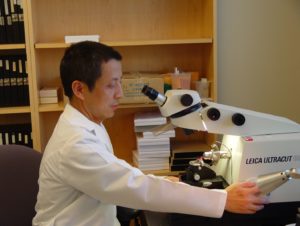- Retina Research Foundation
- About RRF
- Pilot Study Grants
- Grant Recipients 2025
- Samuel M. Wu, PhD
- Yingbin Fu, PhD
- Graeme Mardon, PhD
- Wei Li, PhD
- Yuqing Huo, MD, PhD
- Rui Chen, PhD
- Wenbo Zhang, PhD
- Curtis Brandt, PhD
- Lih Kuo, PhD
- Timothy Corson, PhD
- Jianhai Du, PhD
- Francesco Giorgianni, PhD
- James Monaghan, PhD
- Seongjin Seo, PhD
- Andrius Kazlauskas, PhD
- Erika D. Eggers, PhD
- Ann C. Morris, PhD
- Ming Zhang, MD, PhD
- Christine Sorenson, PhD
- Alex J. Smith, PhD
- Jeffrey M. Gross, PhD
- David M. Wu, MD, PhD
- Kinga Bujakowska, PhD
- Eric Weh, PhD
- Ching-Kang Jason Chen, PhD
- Jakub K. Famulski, PhD
- Thanh Hoang, PhD
- Georgia Zarkada, MD, PhD
- Eleftherios Paschalis Ilios, PhD
- Oleg Alekseev, MD, PhD
- Erika Tatiana Camacho, PhD
- Patricia R. Taylor, PhD
- Elizabeth Vargis, PhD
- Publications
- Grant Guidelines and Information
- Grant Application
- Grant Recipients 2025
- Research Programs
- Contact Us
- Giving
- RRF History
- Home
Yingbin Fu, PhD
 Cullen Eye Institute
Cullen Eye Institute
Baylor College of Medicine
Houston, TX
DANA AND GIL PETRI RESEARCH PROJECT
ATP-citrate lyase as a novel target for neovascular age related macular degeneration
Major Awards
2021 Audacious Goal Initiative Grant award from the NIH
2018 The Helen Juanita Reed Award for Macular Degeneration Research, BrightFocus Foundation
2013 Winner of NEI Challenge to Identify Audacious Goals in Vision Research and Blindness Rehabilitation
Current Research Interests
Age-related macular degeneration (AMD) is a major cause of blindness in the elderly. Choroidal neovascularization (CNV refers to the growth of abnormal leaky blood vessels beneath the retina), the neovascular AMD (nAMD), underlies 80-90% of legal blindness due to AMD.
Plans for 2025
Up to 50% of patients have poor responses to current anti-VEGF treatments, including persistent fluid and unresolved or new hemorrhages. Metabolic pathways have essential roles in regulating blood vessel growth in endothelial cells. ATP citrate lyase (ACLY) is a key enzyme in cellular metabolism that may play a role in nAMD. The objective of this year’s project is to develop a novel treatment for nAMD by targeting ACLY.
Recent studies have introduced a new concept: endothelial cell metabolism drives abnormal vessel growth. Endothelial cells must increase their metabolic activity to rapidly generate energy and incorporate nutrients into biomass as they form new blood vessels. Since ACLY is a key enzyme required for cellular metabolism, we will investigate the role of endothelial ACLY in nAMD using a loss-of function approach by genetically deleting ACLY in endothelial cells. This work will lay the foundation for the therapeutic application of ACLY in AMD. Macrophages, a type of white blood cell that surrounds and kills microorganisms and removes dead cells, play a critical role in anti-VEGF resistance in AMD. Inhibiting ACLY could simultaneously target two key players in nAMD: endothelial cells and macrophages. The second objective is to develop a new therapy to address drug resistance in nAMD by targeting ACLY.
Type of Project: Translational research
Progress in 2024
Targeting subretinal fibrosis in age-related macular degeneration
Current anti-VEGF therapies suppress CNV without inhibiting subretinal fibrotic scar formation, which can lead to permanent vison loss. The objectives of the 2024 project are: 1) to develop a specific imaging tool for in vivo assessment of subretinal fibrosis in nAMD, which is currently lacking; and 2) to develop an effective AIBP/anti-VEGF combination therapy to combat both CNV and subretinal fibrosis by targeting two critical cell types: endothelia cells and macrophages.
Dr. Fu’s lab developed a Collagen Hybridizing Peptide (CHP)-based imaging tool for the long-term, accurate detection of subretinal fibrosis (scar formation) in an AMD model, eliminating the need for repeated injections. This tool is invaluable for both diagnostic and treatment purposes. Additionally, the team demonstrated that the AIBP/apoA-I/anti-VEGF combination therapy significantly reduced subretinal fibrosis, whereas the current anti-VEGF therapy, aflibercept, was ineffective. This finding is highly significant, as it shows that the combination therapy not only overcomes anti-VEGF resistance but also reduces subretinal fibrosis.
Progress in 2023
Targeting subretinal fibrosis in age-related macular degeneration
By comparing gene expression profile of infiltrated ocular macrophages, a type of white blood cell that helps eliminate foreign substances by engulfing foreign materials and initiating an immune response in CNV, Dr. Fu’s data show that different macrophage metabolic reprogramming may be responsible for anti-VEGF resistance. This study is highly significant because it has the potential to lead to the discovery of new targets for combating anti-VEGF resistance. Furthermore, our data suggest a new function of AIBP in accelerating arteriolar CNV, which is characterized by the presence of large-caliber vessels, vascular loops, and profound leakage.
Progress in 2022
During the most recent year, Dr. Fu’s team successfully performed ophthalmic phenotyping of their mouse AMD model of anti-VEGF resistance, which exhibits features similar to anti-VEGF non-responders of human patients (i.e., arteriolar type CNV). This is the first study using indocyanine green angiography (ICGA) to investigate CNV subtype in AMD animal models, and it is highly significant because it makes possible the correlation of the animal models with human studies regarding the relationship between CNV subtype and anti-VEGF responses. Importantly, Dr. Fu showed that the combination therapy was effective in treating anti-VEGF resistance by potently inhibiting arteriolar CNV while the current leading treatment aflibercept monotherapy was ineffective (IOVS, in press). This RRF supported research laid the groundwork for further preclinical studies on the efficacy and safety of the novel AIBP/anti-VEGF combination therapy.
Progress in 2021
Dr. Fu and his collaboration colleague, Dr. Yannis Paulus from University of Michigan, successfully developed the first rabbit AMD model of anti-VEGF resistance. This result is highly significant because it is the first large mammalian AMD model of anti-VEGF resistance for a wide range of pre-clinical studies and has led to the filing of an international patent application of our combination therapy under the Patent Cooperation Treaty (PCT) on May 27, 2021. With the filing, Dr. Fu has taken an important step forward to prepare for an investigational, new drug application (IND) from the FDA and move closer to the introduction of this novel therapy into the clinic.
In September, 2021, Dr. Fu received an Audacious Goal Initiative Grant award (1U24EY033272) from the NIH to advance stem cell therapy for various forms of retinal degeneration including retinitis pigmentosa and AMD. (Press release: https://www.nei.nih.gov/about/news-and-events/news/learning-how-transplanted-neurons-fit-0). Continuous support from RRF over the past four years was instrumental to Dr. Fu’s work, and success in obtaining the highly competitive NIH grant.
Progress in 2020 
During the 2020 grant period, Dr Fu’s team made the surprising discovery that the combination therapy they were studying shows a synergistic effect in combating anti-VEGF resistance and improves efficacy in treating CNV, actually suppressing CNV.
By using the widely used laser-induced CNV mouse model, Dr. Fu planed to develop an adeno-associated viral vector (AAV) based long-term apolipoprotein A-I [apoA-I]-binding protein (AIBP) therapy for CNV to avoid side effects associated with repeated intraocular injections.
Specific Aims: In 2020, his research tested the hypothesis that AIBP can be an effective therapy for AMD and address the limitations of the current anti-VEGF therapy, such as anit-VEGF resistance, atrophic effect and sub-optimal long-term outcomes, by selectively targeting hyperactive VEGFR2 signaling and simultaneously providing a physiological environment to control angiogenesis. The specific aim was to develop AAV vectors that express AIBP and apoA-I, and test their efficacy in the laser-induced CNV mouse model.
To the best of his knowledge, Dr. Fu’s lab established the first AMD model of anti-VEGF resistance by combining advanced age and laser photo-coagulation. He also provided the first evidence that cholesterol-laden macrophages play a critical role in the introducing anti-VEGF resistance in CNV.
Dr. Fu’s research in 2020 resulted in a patent, two publications, and an additional manuscript is in preparation. 2020 Publications
Progress in 2019
Mechanism and treatment strategies for cone photoreceptor degeneration
Due to the rapid progress made on the LCA project, Dr. Fu proposed to switch focus to developing a novel treatment strategy for AMD in 2019. Another reason to pivot direction relates to the fact that LCA is a rare disease whereas AMD affects a large population in the US, and in the world. In 2019, he assessed the therapeutic efficacy of recombinant AIBP in a widely used mouse AMD model.
2019 Specific Aims: To develop a novel AIBP-based therapy for CNV in mouse AMD models by testing the hypothesis that AIBP can be an effective therapy for AMD and by addressing the limitations of the current anti-VEGF therapy (e.g., anti-VEGF resistance, atrophic effect, and suboptimal long-term outcomes) by selectively targeting hyperactive VEGFR2 signaling and simultaneously providing a physiological environment to control angiogenesis – the development of new blood vessels.
A majority of the proposed experiments in 2019 were completed and Dr. Fu found that AIBP treatment is highly effective in inhibiting laser-induced CNV. Additionally, laser-induced CNV in mice with increased age showed an increased resistance to anti-VEGF treatments, correlating with the increased intracellular lipid accumulation in macrophages. To further investigate the role of AIBP in pathogenic angiogenesis in AMD, they examined the expression and localization of AIBP in human donor eyes from AMD patients and controls and found that AIBP is significantly decreased in human CNV specimen. These results were submitted in a manuscript.
Progress in 2018
A unified mechanism for multiple forms of cone photoreceptor degeneration
The mechanism underlying cone death in Leber’s ongenital amaurosis (LCA) is not well understood. the large number of gene mutations involved and diverse functions affected create a challenge in designing LCA treatments. The goal in 2018 was to identify common mechanisms underlying cone death in order to find a common treatment strategy to protect cones and preserve vision across multiple forms of LCAs. Dr Fu discovered a unified mechanism for cone degeneration in LCA. Namely, S-opsin aggregation induced endoplasmic reticulum (ER) stress is responsible for the rapic degeneration of “S-cones” (i.e., blue cones in humans), and M-opsin degradation associated proteasome stress is a major contributor for “M-cone” (i.e., red/green cones in human) degeneration. This discovery has broad implications for cone degeneration in general.
Dr. Fu’s research team proposed to study the role of two types of cone opsins (light detecting protein in the eye) in the degeneration of cone photoreceptors in Leber’s congenital amaurosis (LCA). Aim 1 was to determine the role of S-opsin in cone degeneration in the GC1–/– model by genetically deleting S-opsin. Aim 2 was to test the hypothesis that genetic deletion of M-opsin in Lrat–/– or GC1–/– mice will significantly reduce proteasome stress and therefore prevent or delay the degeneration of M/L (red/green) cones in both models. They were happy to report that they accomplished the majority of the proposed experiments. For Aim 1, they found that cones can survive at least 9 months after genetic deletion of S-opsin. For Aim 2, they found that genetic deletion of M-opsin reduced proteasome stress and prevented red/green cone degeneration for at least one year.

